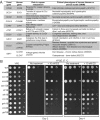Elesclomol restores mitochondrial function in genetic models of copper deficiency
- PMID: 30038027
- PMCID: PMC6094114
- DOI: 10.1073/pnas.1806296115
Elesclomol restores mitochondrial function in genetic models of copper deficiency
Abstract
Copper is an essential cofactor of cytochrome c oxidase (CcO), the terminal enzyme of the mitochondrial respiratory chain. Inherited loss-of-function mutations in several genes encoding proteins required for copper delivery to CcO result in diminished CcO activity and severe pathologic conditions in affected infants. Copper supplementation restores CcO function in patient cells with mutations in two of these genes, COA6 and SCO2, suggesting a potential therapeutic approach. However, direct copper supplementation has not been therapeutically effective in human patients, underscoring the need to identify highly efficient copper transporting pharmacological agents. By using a candidate-based approach, we identified an investigational anticancer drug, elesclomol (ES), that rescues respiratory defects of COA6-deficient yeast cells by increasing mitochondrial copper content and restoring CcO activity. ES also rescues respiratory defects in other yeast mutants of copper metabolism, suggesting a broader applicability. Low nanomolar concentrations of ES reinstate copper-containing subunits of CcO in a zebrafish model of copper deficiency and in a series of copper-deficient mammalian cells, including those derived from a patient with SCO2 mutations. These findings reveal that ES can restore intracellular copper homeostasis by mimicking the function of missing transporters and chaperones of copper, and may have potential in treating human disorders of copper metabolism.
Keywords: copper; cytochrome c oxidase; elesclomol; mitochondria.
Copyright © 2018 the Author(s). Published by PNAS.
Conflict of interest statement
Conflict of interest statement: S.S. and V.M.G. are listed as inventors on a provisional patent application filed by Texas A&M University.
Figures




References
-
- Cobine PA, Ojeda LD, Rigby KM, Winge DR. Yeast contain a non-proteinaceous pool of copper in the mitochondrial matrix. J Biol Chem. 2004;279:14447–14455. - PubMed
Publication types
MeSH terms
Substances
Grants and funding
LinkOut - more resources
Full Text Sources
Other Literature Sources
Molecular Biology Databases
Research Materials

